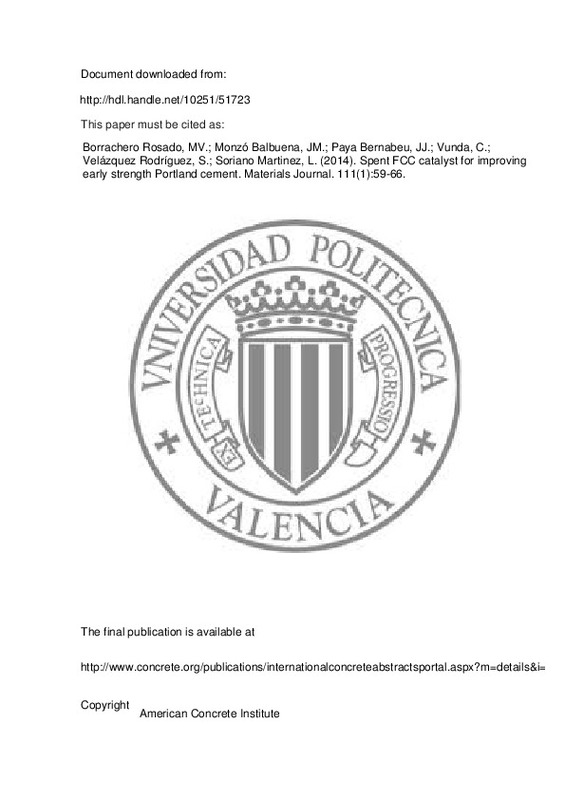JavaScript is disabled for your browser. Some features of this site may not work without it.
Buscar en RiuNet
Listar
Mi cuenta
Estadísticas
Ayuda RiuNet
Admin. UPV
Spent FCC catalyst for improving early strength Portland cement
Mostrar el registro sencillo del ítem
Ficheros en el ítem
| dc.contributor.author | Borrachero Rosado, María Victoria
|
es_ES |
| dc.contributor.author | Monzó Balbuena, José Mª
|
es_ES |
| dc.contributor.author | Paya Bernabeu, Jorge Juan
|
es_ES |
| dc.contributor.author | Vunda, Christian
|
es_ES |
| dc.contributor.author | Velázquez Rodríguez, Sergio
|
es_ES |
| dc.contributor.author | Soriano Martínez, Lourdes
|
es_ES |
| dc.date.accessioned | 2015-06-15T13:23:16Z | |
| dc.date.available | 2015-06-15T13:23:16Z | |
| dc.date.issued | 2014-02 | |
| dc.identifier.issn | 0889-325X | |
| dc.identifier.uri | http://hdl.handle.net/10251/51723 | |
| dc.description.abstract | [EN] Spent fluid catalytic cracking (FCC) catalyst from the petrol industry has proven to be a very active pozzolanic material. This behavior leads to an additional increase in the strength of the mortar that contains this catalyst. Pozzolanic effects tend to be considered for periods above three days, whereas in shorter times, the influence of pozzolan is usually negligible. The reactivity of FCC is so high, however, that both pozzolanic effects and acceleration of cement hydration are evident in short curing times. This paper presents a study of the effect of the presence of FCC on cement hydration and the reaction products in the first 48 hours of curing time, carried out by determining flexural and compressive strength of mortars in three different tests (substitution, addition, and with accelerator). For the FCC behavior comparison, limestone, mullite, and andalusite were used. Finally, the characterization of hydrates was performed by thermogravimetry. | es_ES |
| dc.language | Inglés | es_ES |
| dc.publisher | American Concrete Institute | es_ES |
| dc.relation.ispartof | Materials Journal | es_ES |
| dc.rights | Reserva de todos los derechos | es_ES |
| dc.subject | Mechanical strength | es_ES |
| dc.subject | Pozzolan | es_ES |
| dc.subject | Spent fluid catalytic cracking catalyst | es_ES |
| dc.subject | Thermogravimetry | es_ES |
| dc.subject.classification | INGENIERIA DE LA CONSTRUCCION | es_ES |
| dc.title | Spent FCC catalyst for improving early strength Portland cement | es_ES |
| dc.type | Artículo | es_ES |
| dc.rights.accessRights | Abierto | es_ES |
| dc.contributor.affiliation | Universitat Politècnica de València. Departamento de Ingeniería de la Construcción y de Proyectos de Ingeniería Civil - Departament d'Enginyeria de la Construcció i de Projectes d'Enginyeria Civil | es_ES |
| dc.contributor.affiliation | Universitat Politècnica de València. Instituto de Ciencia y Tecnología del Hormigón - Institut de Ciència i Tecnologia del Formigó | es_ES |
| dc.description.bibliographicCitation | Borrachero Rosado, MV.; Monzó Balbuena, JM.; Paya Bernabeu, JJ.; Vunda, C.; Velázquez Rodríguez, S.; Soriano Martinez, L. (2014). Spent FCC catalyst for improving early strength Portland cement. Materials Journal. 111(1):59-66. http://hdl.handle.net/10251/51723 | es_ES |
| dc.description.accrualMethod | S | es_ES |
| dc.relation.publisherversion | http://www.concrete.org/publications/internationalconcreteabstractsportal.aspx?m=details&i=51686545 | es_ES |
| dc.description.upvformatpinicio | 59 | es_ES |
| dc.description.upvformatpfin | 66 | es_ES |
| dc.type.version | info:eu-repo/semantics/publishedVersion | es_ES |
| dc.description.volume | 111 | es_ES |
| dc.description.issue | 1 | es_ES |
| dc.relation.senia | 283198 |





![[Cerrado]](/themes/UPV/images/candado.png)

